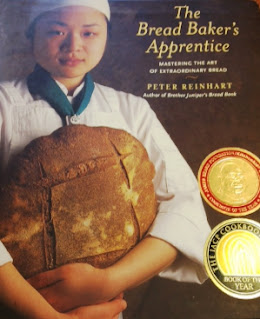 |
| Book Cover showing a Poilâne Style Miche |
My wild-yeast starter grew just exactly as the book described. The mother starter as well. I went on to make an Onion Deli Rye which was fantastic. Then I tried a 100% Sourdough Rye. I did add a tiny bit of yeast to help things along, as the weather at the time was awfully cold and the house, though heated, just felt cool. That bread, as well as the Sunflower Seed Rye, just didn't quite grow the way the book indicated. While I have nothing against, and sometimes even prefer a very dense bread, these two didn't quite look like the book's photos.
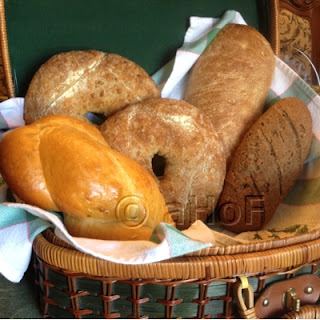 |
| Challah, Sunflower Seed Rye, Deli Rye, 100% Sourdough Rye |
Who is Poilâne and What the Heck is a Miche?
Okay, according to Peter Reinhart's book (as well as most any website out there), Lionel Poilâne is a bread baker of such repute that his "miche" (rustic sourdough whole wheat bread) is now just lovingly called "Pan Poilâne" (or Poilâne Bread). His recipe is simple: sourdough starter, whole wheat flour, Fleur de Sel de Guerande and water. Of course, Poilâne uses a wood fired oven for his huge 4-pound rustic miche loaves.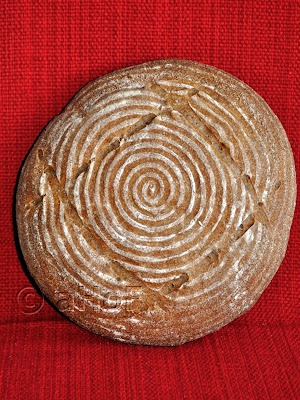 |
| My Poilâne Style Miche |
Reinhart suggests dividing the dough into two or even three smaller loaves for home baking, as trying to manipulate 4 pounds of dough into the oven could be a task. I went farther and just divided the recipe itself in half. Reinhart gives no poundage weight for this recipe as he does for all his other recipes. Generally it is noted in a recipe that it will "make two 1-pound loaves" or something such. The recipe, cut in half as I made it, weighed 2 pounds. It was a majestic loaf, and I used my "banneton" or bread mold for the first time to give the loaf visual interest. Once the dough has risen, ready to bake, a Bread Lame is used to slash in a pound-sign or "hash-tag" type of pattern. Poilâne slashes his "Pans Poilâne" with a large script "P."
My Poilâne-Style Miche
 |
| Poilânes "Pan Poilâne" or Miche (photo from website) |
After allowing the dough to rise for 4 hours and be shaped into a boule, or round loaf, the book gives the option of allowing the dough to rise in the pan and then turning out and baking, or just putting the shaped dough into the refrigerator once more overnight, to retard growth and add more flavor. Whole wheat bread can be blah, so I was all about more flavor. I formed the boule and set it into my well-floured banneton, covered it and refrigerated.
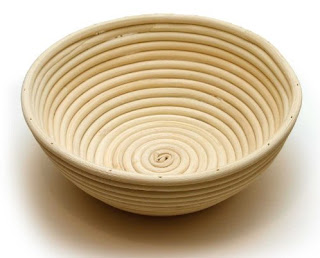 |
| My Banneton or bread form |
The only tricky part was getting the dough out of the banneton. I floured it heavily before placing the dough in. It came out reluctantly. There was a fair amount of deflation caused by this slow release from the mold. Still, after a few minutes it was very obviously recovering. I made the slashes over top of the pretty pattern from the bread mold and slid it onto my new oven stone.
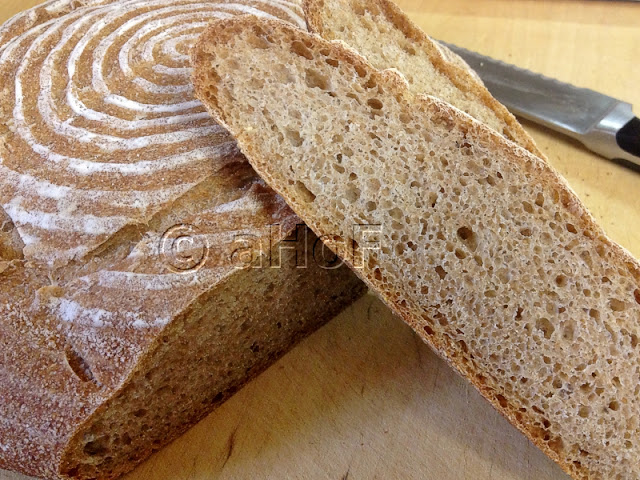 |
| Beautiful Crumb |
The bread came out so beautifully. I nearly cried. It is a joy to behold. It tastes wonderful, particularly for a whole wheat loaf. I hope anyone out there who loves bread baking might attempt this recipe.
My passion is teaching people how to create a harmony of flavors with their cooking, and passing along my love and joy of food, both simple or exotic, plain or fancy. I continue my journey in ethnic and domestic cuisines, continuing my journey to explore diverse culinary experiences and hopefully to start you on a journey of your own. Join me also at A Harmony of Flavors on Facebook, and Pinterest.

No comments:
Post a Comment